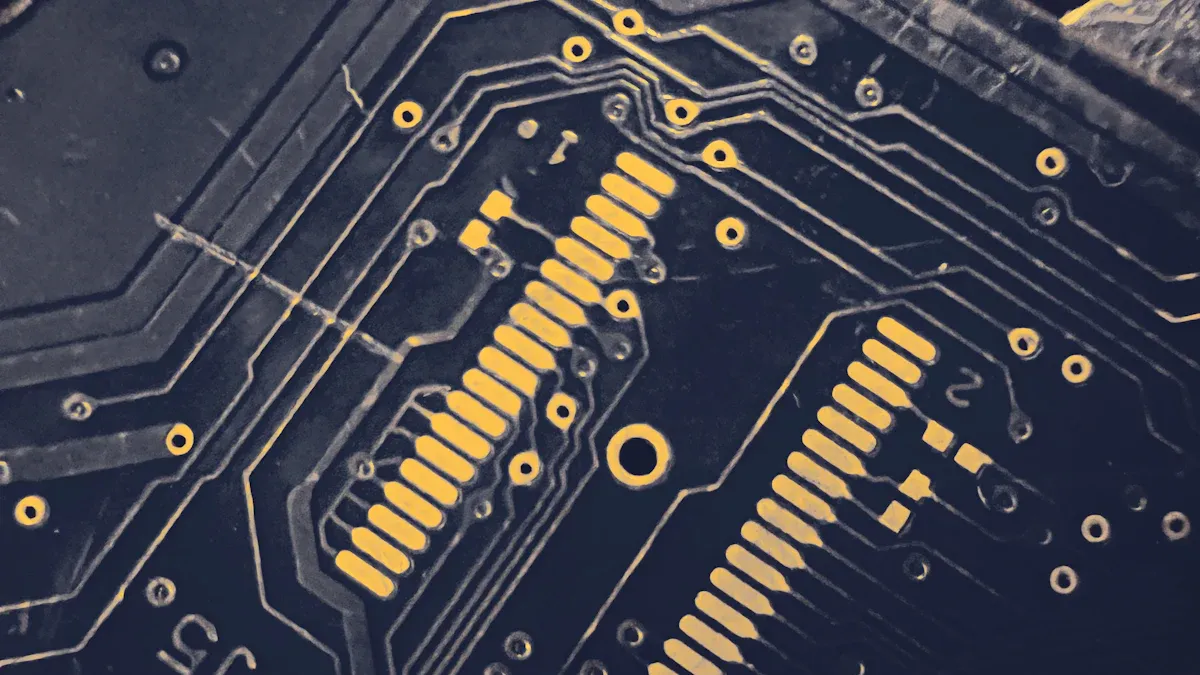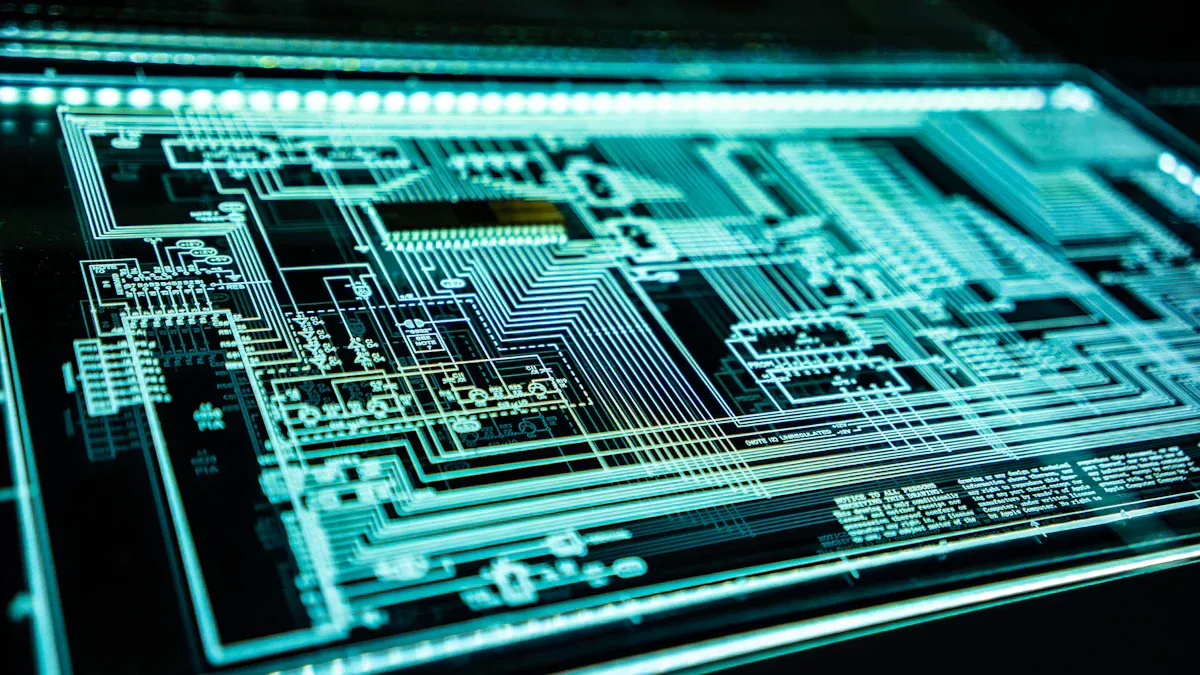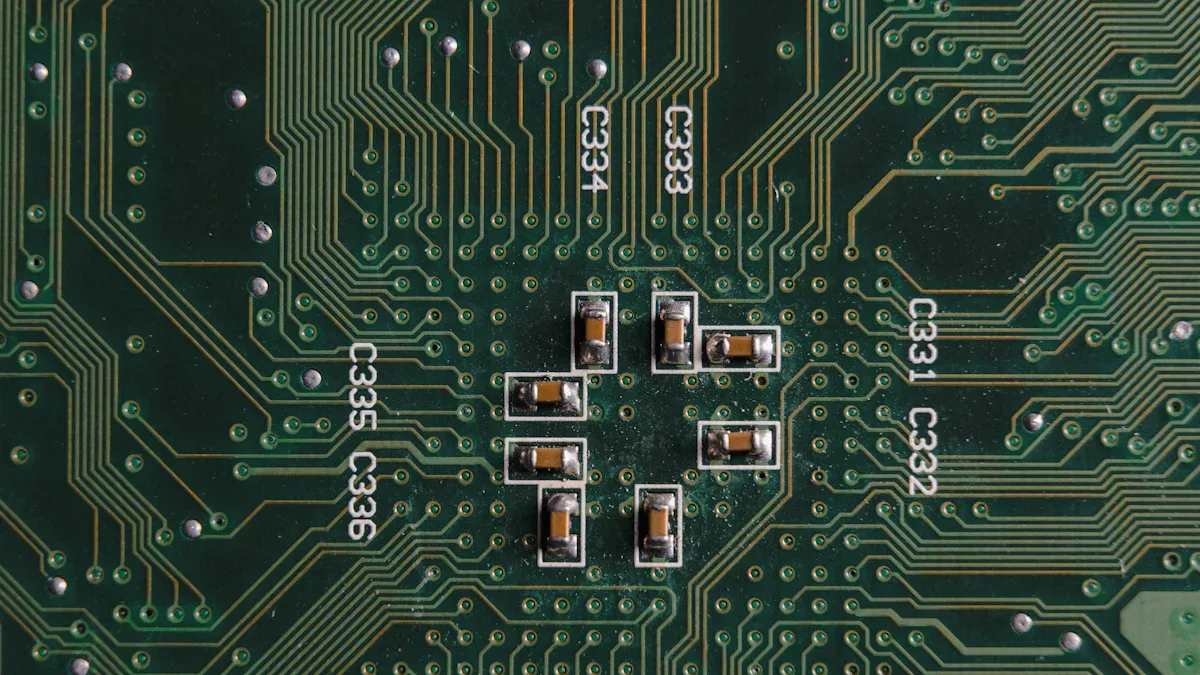What Are IC Line Drivers and How Do They Work in Electronics

In electronics, an IC line driver helps you transmit signals over long distances without losing quality. It works by boosting the signal strength and reducing noise, ensuring that the information reaches its destination accurately. This makes it essential for maintaining reliable communication in noisy environments. Whether you deal with data transmission or audio systems, an IC line driver ensures your signals remain intact, even under challenging conditions. By preserving signal integrity, it plays a vital role in modern connectivity and electronics.
Key Takeaways
IC line drivers make signals stronger for better long-distance communication.
They use differential signaling to block noise, helping with fast data transfer.
Choosing the right IC line driver means checking needs and conditions.
Keeping signals clear is important; bad signals can cause errors or failures.
IC line drivers are used in communication, audio, and factory machines.
What Are IC Line Drivers?

Definition and Purpose
An IC line driver is a specialized integrated circuit designed to transmit signals efficiently over long distances or through noisy environments. Its primary purpose is to ensure that the signal remains strong and clear, even when external factors like interference or distance could degrade it. These devices are essential in modern electronics, where reliable communication is critical.
IC line drivers function as differential drivers, which improve noise resistance by sourcing and sinking higher currents compared to standard outputs. They also act as electronic amplifier circuits, controlling loads such as transmission lines. By adjusting their output resistance to match the line resistance, they maintain signal quality. Additionally, they consist of a set of transistors packaged in an IC, enabling them to handle higher power outputs while being controlled by low-power inputs.
Definition/Purpose | Description |
|---|---|
Differential Driver | Improves noise-proofing by allowing for higher current sourcing and sinking. |
Electronic Amplifier Circuit | Controls loads like transmission lines, with adjustable output resistance. |
Set of Transistors | Enables higher power outputs from low-power inputs by sourcing or sinking power. |
Key Characteristics of IC Line Drivers
IC line drivers possess several key characteristics that make them indispensable in electronics. These features allow them to outperform traditional circuitry in signal transmission:
Feature | IC Line Drivers | Traditional Circuitry |
|---|---|---|
Output Current Capability | Limited current sourcing/sinking | |
Voltage Drop | Less voltage drop, closer to VCC/GND | Higher voltage drop |
Adaptive Circuitry | Matches output impedance to load | Fixed impedance |
Cable Run Support | Ideal for longer cable runs | Limited distance support |
These characteristics make IC line drivers ideal for applications requiring long-distance signal transmission or operation in environments with significant electrical noise. Their ability to adapt to varying load conditions ensures consistent performance across different systems.
Why Signal Integrity Matters in Electronics
Signal integrity is crucial for the reliable performance of electronic devices. Poor signal quality can lead to data loss, device malfunctions, or even complete system failures. High-quality signals prevent issues like bit flips or "amnesia," which can disrupt the functionality of your devices. Maintaining controlled impedance is especially important for high-frequency signals on printed circuit boards (PCBs), as it ensures that the signal remains stable and undistorted.
High-quality signals prevent errors like bit flips, which can cause device failures.
Controlled impedance ensures stable signal transmission, especially for high-frequency signals.
Poor signal quality can degrade device performance over time, reducing reliability.
By using an IC line driver, you can maintain signal integrity even in challenging conditions. This ensures that your electronic systems perform reliably and efficiently, regardless of the environment.
How Do IC Line Drivers Work?
The Principle of Differential Signaling
Differential signaling is a key method used by an IC line driver to ensure reliable data transmission. Instead of sending a single signal, it transmits two complementary signals along a pair of wires. The receiving end measures the difference between these signals, which cancels out any noise picked up during transmission. This technique enhances noise immunity and improves signal quality.
They support high-speed networks, such as 5G, where maintaining signal integrity is critical.
The demand for differential signaling continues to grow due to its ability to handle data-centric applications effectively.
By using this approach, you can achieve faster and more reliable communication, even in environments with significant electrical interference.
Noise Reduction and Signal Amplification
Noise can distort signals, making it harder for devices to interpret the transmitted data. An IC line driver reduces noise by amplifying the desired signal while suppressing unwanted interference. Advanced techniques, such as adaptive filters and spectral subtraction, further enhance signal clarity.
Adaptive filters, like Kalman filters, isolate the desired signal from background noise, improving the signal-to-noise ratio.
Spectral subtraction techniques have shown to increase SNR values from 10-13 dB to 16-19 dB, significantly reducing background noise.
Proper signal amplification ensures that the signal strength increases without introducing distortion.
These methods ensure that your signals remain clear and accurate, even in noisy environments.
Maintaining Signal Quality Over Long Distances
Transmitting signals over long distances can lead to attenuation, where the signal weakens as it travels. An IC line driver combats this by boosting the signal strength and using high-quality transmission lines. Additional measures, such as shielding and error-correction technologies, further preserve signal integrity.
Signal amplifiers or repeaters can be placed at intervals to maintain signal strength.
Low-loss materials in transmission lines minimize attenuation.
Shielding and error-correction systems protect data from degradation during transmission.
These strategies allow you to maintain reliable communication across extended distances, ensuring that the transmitted data remains intact.
Key Features and Specifications of IC Line Drivers
Voltage and Current Ratings
Voltage and current ratings define how much power an IC line driver can handle. These ratings ensure the driver operates efficiently without overheating or signal distortion. For example, the supply voltage range typically spans from 2.0 to 6.0 volts, making it suitable for various applications. The headroom voltage, which is the difference between the supply voltage and the maximum output voltage, ensures the driver delivers consistent performance under load.
Quiescent current is another critical factor. It represents the minimum current required for the driver to function without clipping the signal. Managing power dissipation is equally important. Excessive power can lead to overheating, so IC line drivers are designed with low-power dissipation CMOS technology to maintain reliability.
Characteristic | Description |
|---|---|
Headroom Voltage | Ensures consistent output performance under load. |
Quiescent Current | Prevents signal clipping by maintaining a minimum current. |
Power Dissipation | Keeps the driver cool and reliable during operation. |
Speed and Bandwidth Considerations
The speed and bandwidth of an IC line driver determine how quickly it can transmit data. High-speed drivers support fast communication protocols like Ethernet and USB. Bandwidth, measured in hertz, defines the range of frequencies the driver can handle without distortion. A wider bandwidth ensures the driver can process high-frequency signals effectively.
For instance, drivers with adaptive circuitry can match their output impedance to the load, minimizing signal loss. This feature is crucial for maintaining signal integrity in high-speed networks.
Compatibility with Communication Protocols
An IC line driver must be compatible with the communication protocols used in your system. Protocols like RS-485, Ethernet, and HDMI require specific voltage levels and signaling methods. The driver’s design ensures seamless integration with these protocols, enabling reliable data transmission.
Additionally, features like high noise-proofing and wide operating temperature ranges (-40°C to 125°C) make these drivers suitable for demanding environments. Their robust design ensures compatibility across various applications, from industrial automation to consumer electronics.
Feature | Description |
|---|---|
Noise-Proofing | High noise-proofing |
Operating Temperature | -40°C to 125°C |
Applications of IC Line Drivers in Electronics

Communication Systems (e.g., Ethernet, RS-485)
IC line drivers are essential in communication systems like Ethernet and RS-485. These systems rely on transmitting data over long distances while maintaining signal integrity. You can use IC line drivers to boost signal strength and reduce noise, ensuring reliable data transmission even in challenging environments.
For example, in RS-485 communication, IC line drivers enable high-speed data transfer over extended distances. They also support differential signaling, which minimizes the impact of electrical interference. This makes them ideal for industrial and commercial applications where reliability is critical.
The performance of IC line drivers in communication systems can be seen in the following comparison:
Feature | Without Preemphasis | With Preemphasis |
|---|---|---|
Maximum Distance (1Mbps) | 11700ft/518m | 3400ft/1036m |
Maximum Data Rate (4000ft) | 400kbps | 800kbps |
Jitter at 1Mbps | 10% | 10% |
Jitter at 4000ft | 10% | 10% |
This table highlights how IC line drivers improve data rates and transmission distances. By using preemphasis techniques, you can achieve better performance in your communication systems.
Audio Systems and Signal Processing
In audio systems, IC line drivers play a crucial role in delivering clear and distortion-free sound. They amplify audio signals and ensure they remain strong over long cable runs. This is especially important in professional audio setups, where signal quality directly impacts the listening experience.
You can find IC line drivers in devices like mixers, amplifiers, and audio interfaces. These drivers help maintain signal integrity by reducing noise and interference. For instance, in a recording studio, IC line drivers ensure that audio signals from microphones or instruments reach the mixing console without degradation.
Additionally, IC line drivers support balanced audio connections, which use differential signaling to cancel out noise. This makes them a preferred choice for high-quality audio applications.
Industrial Automation and Control Systems
Industrial automation relies heavily on IC line drivers for efficient and reliable communication between devices. These drivers enable data transmission over long distances, even in electrically noisy environments. You can use them in systems like programmable logic controllers (PLCs), motor drives, and sensors.
IC line drivers ensure that signals remain strong and accurate, which is vital for controlling machinery and processes. For example, in a factory setting, IC line drivers allow sensors to send data to a central controller without signal loss. This ensures that the system operates smoothly and efficiently.
Their robust design also makes them suitable for harsh industrial environments. With features like wide operating temperature ranges and high noise immunity, IC line drivers can handle the demands of industrial applications.
Automotive and Medical Devices
IC line drivers play a vital role in the automotive and medical industries, where precision and reliability are non-negotiable. These devices ensure that signals remain strong and accurate, even in environments with high electrical noise or extreme conditions.
Automotive Applications
In modern vehicles, you rely on IC line drivers to support advanced communication systems. These systems connect various components, such as sensors, controllers, and actuators, to ensure smooth operation. For example, in electric vehicles (EVs), IC line drivers help manage battery systems by transmitting data between the battery management system (BMS) and other modules. This ensures the vehicle operates efficiently and safely.
You also find IC line drivers in automotive infotainment systems. They enable high-quality audio and video transmission, ensuring a seamless entertainment experience for passengers. Additionally, they support safety features like advanced driver-assistance systems (ADAS), where reliable data transmission is critical for functions such as collision detection and lane-keeping assistance.
Tip: When selecting an IC line driver for automotive use, look for features like wide temperature ranges and high noise immunity. These ensure the device performs reliably in harsh conditions.
Medical Applications
In the medical field, IC line drivers contribute to the accuracy and reliability of diagnostic and monitoring equipment. Devices like electrocardiograms (ECGs), ultrasound machines, and patient monitors rely on these drivers to transmit signals without distortion. This ensures that healthcare professionals receive accurate data for diagnosis and treatment.
For instance, in imaging systems like MRI or CT scanners, IC line drivers maintain signal integrity during data transmission. This is crucial for producing clear and detailed images. Similarly, in wearable medical devices, they enable continuous monitoring by ensuring that data from sensors reaches the processing unit without interference.
You also benefit from their role in telemedicine. IC line drivers facilitate high-speed data transmission, enabling real-time communication between patients and healthcare providers. This is especially important in remote areas where reliable connectivity can save lives.
Note: In medical applications, compliance with safety standards like IEC 60601 is essential. Ensure the IC line driver you choose meets these requirements to guarantee patient safety.
How to Select the Right IC Line Driver
Assessing Application Requirements
Choosing the right IC line driver starts with understanding your application’s needs. Consider the type of signals you want to transmit. For example, audio signals require drivers with low distortion, while data communication systems need high-speed drivers. Identify the distance over which the signal must travel. Longer distances demand drivers with higher output power to maintain signal strength.
Think about the environment where the driver will operate. Industrial settings may expose the driver to electrical noise, so you’ll need one with strong noise immunity. For automotive or medical applications, look for drivers that meet specific industry standards. By clearly defining your application requirements, you can narrow down your options and make a more informed choice.
Evaluating Technical Specifications
Once you know your application needs, evaluate the technical specifications of the IC line driver. Start with the voltage and current ratings. Ensure the driver can handle the power levels required by your system without overheating. Check the bandwidth and speed. High-speed applications, like Ethernet or HDMI, need drivers with wide bandwidth to handle fast data rates.
Look at the driver’s impedance-matching capabilities. A driver that matches the load impedance minimizes signal loss and ensures efficient transmission. Also, review the quiescent current and power dissipation. Low power consumption is essential for energy-efficient systems. Comparing these specifications helps you find a driver that meets your technical demands.
Considering Environmental Factors (e.g., temperature, noise)
Environmental factors play a significant role in selecting an IC line driver. If the driver will operate in extreme temperatures, choose one with a wide operating temperature range. For example, industrial and automotive applications often require drivers that function reliably between -40°C and 125°C.
Noise is another critical factor. In noisy environments, select a driver with high noise immunity or differential signaling capabilities. This ensures the signal remains clear despite interference. Additionally, consider the physical size of the driver if space is limited in your design. By accounting for these environmental factors, you can ensure the driver performs reliably in your specific conditions.
IC line drivers play a vital role in modern electronics by ensuring reliable signal transmission. You can find them in a wide range of applications, including communication systems, industrial automation, and medical devices. Their ability to maintain signal integrity makes them indispensable in noisy or demanding environments. When choosing an IC line driver, focus on your application’s requirements, technical specifications, and environmental conditions. This approach ensures optimal performance and long-term reliability for your electronic systems.
FAQ
What is the difference between an IC line driver and a line receiver?
An IC line driver sends signals, while a line receiver interprets them. The driver ensures the signal remains strong during transmission. The receiver decodes the signal at the destination. Together, they enable reliable communication in electronic systems.
Can IC line drivers work in extreme temperatures?
Yes, many IC line drivers are designed for wide temperature ranges, such as -40°C to 125°C. This makes them suitable for industrial, automotive, and outdoor applications where extreme conditions are common.
How do IC line drivers reduce noise?
IC line drivers use differential signaling to cancel out noise. They send two complementary signals, and the receiver measures the difference. This method eliminates interference picked up during transmission, ensuring clear and accurate signals.
Are IC line drivers compatible with all communication protocols?
No, IC line drivers must match the specific protocol requirements of your system. For example, RS-485, Ethernet, and HDMI have unique voltage levels and signaling methods. Always check compatibility before selecting a driver.
Do IC line drivers consume a lot of power?
Not necessarily. Many modern IC line drivers use low-power CMOS technology to minimize energy consumption. Look for drivers with low quiescent current and efficient power dissipation to ensure energy-efficient operation.
Tip: Always review the power specifications of the IC line driver to match your system's needs.
See Also
Exploring Industrial Control Chips and Their Automation Functions
Defining IC Demodulators and Their Importance in Technology
Fundamentals of Analog IC Design and Its Uses
